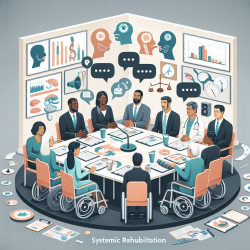The systematic review adhered to PRISMA guidelines and analyzed various studies focusing on telerehabilitation for children with neurodevelopmental or neurological disorders. The key aspects evaluated included the type of technology used, outcomes, caregiver involvement, and dosage of interventions.
Key Findings
The review highlighted several critical findings:
- Technological Diversity: Most telerehabilitation technologies are commercial devices, with a significant number also using research prototypes and clinical software. This diversity allows for high personalization and efficacy in treatment.
- Outcomes: The majority of studies targeted motor and neuropsychological functions, while fewer explored language or multi-domain protocols. Outcome measures were categorized according to the International Classification of Functioning, Disability, and Health (ICF).
- Caregiver Involvement: Although caregivers were rarely the direct target of interventions, their role was crucial in home-based rehabilitation settings. The review found that active caregiver involvement often led to better outcomes.
- Dosage and Efficacy: The review found that higher intensity and frequency of telerehabilitation sessions were associated with better outcomes. However, the variability in study designs and outcome measures made it challenging to draw definitive conclusions.
Practical Implications for Practitioners
For practitioners looking to implement telerehabilitation protocols, the review offers several actionable insights:
- Choose the Right Technology: Select technologies that allow for personalization and can be adapted to the specific needs of each child.
- Engage Caregivers: Actively involve caregivers in the rehabilitation process. Training sessions for caregivers can significantly enhance the effectiveness of the intervention.
- Monitor and Adjust: Regularly monitor the child's progress and adjust the intervention protocols as needed. Adaptive technologies that automatically modulate difficulty levels based on performance can be particularly useful.
- Focus on Dosage: Ensure that the rehabilitation sessions are frequent and intensive enough to make a meaningful impact. The review suggests that a higher dosage correlates with better outcomes.
Encouraging Further Research
The review also highlights the need for further research in several areas:
- Standardized Taxonomy: There is a need for a standardized classification system for digital technologies used in telerehabilitation to improve comparability and reproducibility in research.
- Multi-domain Protocols: More studies are needed to explore multi-domain rehabilitation protocols that address motor, neuropsychological, and language functions simultaneously.
- Long-term Efficacy: Future research should focus on the long-term efficacy of telerehabilitation interventions, including their impact on quality of life and daily functioning.
By implementing these insights and continuing to explore the potential of telerehabilitation, practitioners can significantly improve outcomes for children with neurologic and neurodevelopmental disorders.
To read the original research paper, please follow this link: The wide world of technological telerehabilitation for pediatric neurologic and neurodevelopmental disorders: a systematic review.










